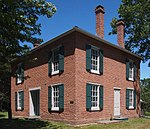Freeway Sanitary Landfill
The Freeway Sanitary Landfill is a United States Environmental Protection Agency Superfund site that covers 140 acres (57 ha) in Burnsville, Minnesota. In 1971 the Minnesota Pollution Control Agency (MCPA) licensed the landfill to accept 1,920 acre-feet (2,370,000 m3) of household, commercial, demolition, and nonhazardous industrial wastes. The state permit prohibited the disposal of liquids and hazardous wastes; however, heavy metals, acids, and bases were accepted by the landfill from local industries. The landfill also accepted 200 cubic yards (150 m3) of battery casings and 448 short tons (406,000 kg) of aluminum sweat furnace slag. Overall, the landfill contains nearly 5,000,000 cubic yards (3,800,000 m3) of waste. The waste is covered by a low permeability soil cover. Groundwater contains contaminants which exceed drinking water standards, including volatile organic compounds (VOCs) such as tetrachloroethylene and vinyl chloride, and manganese and thallium. City of Burnsville municipal wells are located about 4,000 feet (1,200 m) to the south of the landfill. These wells serve approximately 36,000 people. Currently the groundwater beneath the Freeway Landfill flows south into the Kraemer Quarry due to long term dewatering of the quarry for mining purposes. When this pumping ceases the ground water flow will be reversed and the contaminated ground water will flow into the Minnesota River approximately 400 feet (120 m) from the landfill.
Excerpt from the Wikipedia article Freeway Sanitary Landfill (License: CC BY-SA 3.0, Authors).Freeway Sanitary Landfill
West Black Dog Road,
Geographical coordinates (GPS) Address Nearby Places Show on map
Geographical coordinates (GPS)
| Latitude | Longitude |
|---|---|
| N 44.795 ° | E -93.295833333333 ° |
Address
West Black Dog Road
West Black Dog Road
55337
Minnesota, United States
Open on Google Maps









